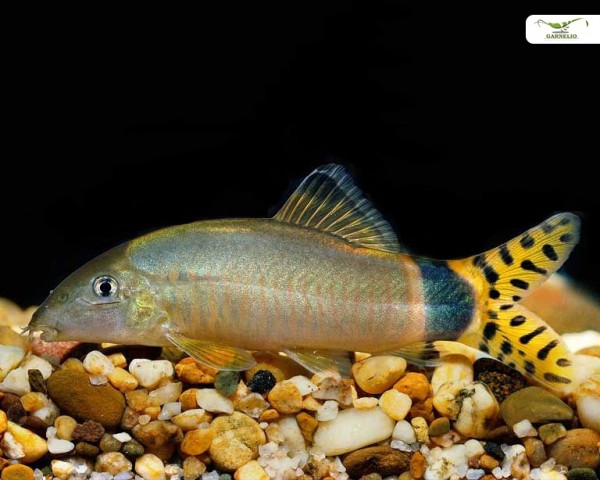incl. VAT plus shipping costs
Currently not available
Delivery only innh. Germany and Austria possible.
Switch to the German store
- Item no: 7740
Fast delivery times
All products are in stock with us!14 years of breeding experience
Let our team of experts advise you!High customer satisfaction
from over 3,000 reviews "| Origin: | Asia |
| Fish group: | Loaches |
| Temperature: | 20-25 °C |
| Behavior: | Active |
| Aquarium size: | 400/450 l (approx. 150cm) |
| with snails/shells?: | No |
| Difficulty: | 4 - Special |
| Planting possible?: | conditional* (see description) |
| Water values: | Soft water |
| Pelvic region: | Below |
| Final size: | 8-12 cm |
| Visual effect: | Especially colorful |
| Feature: | dynamic group behavior |
| with large crabs?: | No |
| with fish?: | conditional* (see description) |
| Breeding: | heavy |
| Diet: | molluskivor - snail eater |
| with dwarf crabs?: | No |
| with shrimps?: | Socialization not possible |
| with crabs?: | No |
The Magnificent Loach, Yasuhikotakia splendida, also called Jaguar Loach, described only in 1995, is a rarity among loaches, which is not too common in the trade. Our animals were not caught wild, as is usually the case, but are European offspring, which are about 4-6 cm in size when delivered. Originally from northern Thailand, they are caught in a very small and difficult to access area. In their natural habitat they are found in clear flowing waters with rocky bottoms. Their strangely named species name is due to the fishologist Yasuhiko Takia.
With a final size of 10 cm the Magnificent Loach does not grow too big. It has a spindle-shaped, slightly high-backed almost scaleless body with a pointed mouth surrounded by a thick mucous membrane, which it also uses to meet its oxygen needs. The mouth has two pairs of barbels. Likewise, the magnificent loach is an intestinal breather. Their basic color is silver-golden, on which several silver bands extend from the flanks to the lateral line and partly beyond. The fins are transparent with some yellow tinge, the dorsal fin can be yellowish with black spots as well as the caudal fin. There is a black high band edged in yellow on the caudal fin root. Magnificent loaches have sub-eye spines that they can unfold and erect for protection from predators.
Magnificent Gorgeous Loaches are not an overly common fish that belong in the hands of experienced aquarists. These great bottom dwellers should always be kept in a larger group, as they settle their intra-species friction among themselves. Their very interesting social behavior, in which they form a clear pecking order, is unique. Therefore, these animals should never be kept alone, otherwise they can become the underwater terrorist they are commonly thought to be - all they miss are their mates!
Magnificent clown loaches are difficult to distinguish externally by sex. Breeding under conventional aquarium conditions has not been successful to date. In its country of origin, the Jaguar Loach is bred commercially for export, but the breeding method is not feasible and rather uninteresting for the aquarist.
Since this fish should be kept in larger groups, the aquarium should also have at least 150 cm edge length, or 300 liters of water volume. The substrate can be a light sand or rounded gravel with larger pebbles and must have dense planting in places, but also floating plants that block the incidence of light. It may be that the animals eat very fine plants. Since Magnificent Loaches are rather nocturnal, they do not like direct lighting, so the aquarium should have shady areas and hiding places. They are quite tolerant of water values and easy to care for, but a rather acidic environment serves their well-being, which can be easily recognized by their distinct coloration. A certain current in the aquarium is quite beneficial to them. Since the animals tend to jump occasionally, their aquarium should be well covered.
Basically Magnificent Loaches behave rather neutral towards other fish, aggressive behavior becomes noticeable, however, if their group consists of too few animals. Although they tend to scuffle and seem to be incredibly quarrelsome, this behavior is due to their very pronounced hierarchy, which is constantly clarified, which is why their aquarium must be appropriately large, so that lower-ranking animals can retreat. Because of this a socialization with other bottom dwellers is rather not recommended, also invertebrates are unsuitable. Fish that live in the upper to middle water zone are no problem. Like other loach species, these animals are considered excellent snail exterminators. They should also be transferred and acclimated very carefully, as they are prone to white spot disease when stressed and are not copper tolerant. When using drug treatments, care should be taken to ensure that the drug is compatible with loaches.
It has no special demands on food and can be fed with live food and frozen food, but also granules, dry food and flake food, as well as sinking wafers, chips and tablets. A regular variety of live food and frozen food will contribute to their well-being.
Our food recommendation: The NatureHolic Catfish Feed for all aufwuchs feeding sucking catfish in the aquarium is a balanced tablet food, which does not cloud the water and the fish like to eat. The catfish tablets also contain NatureHolic active ingredient complexes that provide sucking catfish with everything they need for a strong immune system, healthy growth and great, contrasting coloration. As a snack, supplemental food or vacation food, we recommend the CatfishPlates.
Our plant recommendation: Use for planting NatureHolic InVitros. These are free of snails, planarians and other unwanted co-inhabitants. Also free of algae spores, bacteria and fungi.
Expert Tip: We recommend for fish keeping the NatureHolic 3 Phase Liquid. The care set offers the best all-round protection for your animals. It ensures optimal conditions for successful breeding and keeping.
| Scientific name: | Yasuhikotia splendida |
| German Name: | Magnificent splendid loach, jaguar splendid loach |
| Difficulty level: | advanced |
| Origin/Distribution: | Northern Thailand, Laos |
| Coloration: | stone-gray body with silver "tiger stripes", two pairs of barbels, caudal fin spotted yellow black |
| Age expectancy | unknown |
| Water parameters: | GH 2-15, KH 2-6, pH 6-7, temperature 22-24°C |
| Tank size: | 300 l and up |
| Food | Omnivorous, aufwuchs, algae, live and frozen food, dry food, granules, chips, wafers, tablets, food snails |
| Breeding | not breedable |
| Behavior | territorial and aggressive towards conspecifics |
| Group size | at least 6 animals |
| Further information | Ten typical aquarium fish for beginners and alternatives to them, Tips for acclimating fish to the aquarium, Feeding aquarium fish properly - cheap food and what it can do |
- Item no: 7740
Entdecke die Garnelio Welt!
Garnelio gehört zu den größten Onlineshops für wirbellose Aquarientiere weltweit.
Viele Artikel gibt es exklusiv nur bei uns im Shop.






